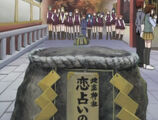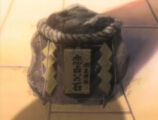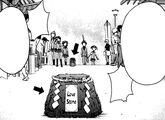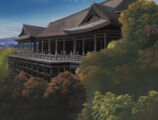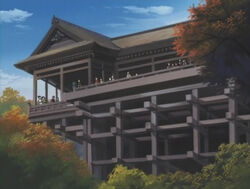
The Kiyomizu Temple (Kiyomizu-dera, 清水寺), officially known as Otowa-san Kiyomizu-dera is an independent Buddhist temple built on the hillside of Mount Otowa in eastern Kyoto.
Founded in the early Heian period, the temple's main hall has a large veranda, supported by tall pillars, which juts out over the hillside and offers impressive views of Kyoto.
The main hall was built around, and ultimately named after, the Otowa-no-taki waterfall, where a shrine was built to cause three channels of water from the waterfall to fall into a pond.
Kiyomizudera has long been a destination for pilgrims and is Kyoto's most popular tourist destination, attracting about 4.5 million visitors each year and possessing a total of thirty structures of varying religious significance. The temple is part of the Historic Monuments of Ancient Kyoto and became a UNESCO World Culture Heritage site in 1994.
History
It is said that in the year 778, Buddhist priest Enchin was inspired by a divine dream to travel up Kizu-gawa river to find a fountain of pure water at the foot of Mount Otowa. There he met Gyoei Koji, a Buddhist hermit, and was given a block of sacred wood. Enchin carved a statue of Kannon Bosatsu out of the block and enshrined it in the thatched hut which Gyoei had been living within.
Two years later, a military General "Sakanoue no Tamuramaro" (758-811) traveled up the mountain on a hunting expedition and met Enchin who lectured him on the merciful teaching of Kannon after admonishing him for killing a deer. Tamuramaro converted to Buddhism and became a devotee to Kannon and issued the building of a hall for the statue in 798.
Originally, the Kiyomizu temple was connected to the Kofuku-ji temple in Nara and had become part of a feud with the Enryaku-ji temple resulting in factional strife that began around the year 999. Since then, fires in 1146 and 1165 were set by the followers of Enryaku-ji and most of Kiyomizu's buildings were burned down by fires of war in 1469 and 1629. Having been rebuilt at least 10 times, the main hall of the temple was rebuilt from 1631 to 1633 during a restoration order by Iemitsu Tokugawa (the grandson of Ieyasu Tokugawa) during the Edo period. Additional verandas and halls were constructed during the period to accommodate large numbers of pilgrims.
Locations
Otowa-no-taki Waterfall


Visitors can drink the waters, which is believed to have therapeutic properties. Drinking the water of the three streams is said to confer (from left to right although sources vary) academic achievement, fortune in love, and longevity depending on which stream you drink from.
Although it is possible to drink from all three, some Japanese believe that you must choose only two; if you are greedy and drink from all three, you invite misfortune upon yourself and none of the streams' benefits will be granted.
You are supposed to make a wish to the Fudomyo-o behind the falls, use the ladle to collect water from the stream and drink it all in one cup.
It is believed that if one drinks the water from the ladle in two gulps, one receives only half of its benefits; if drunk in three gulps, only a third. It is best to take it all in one drink, if possible.
Jishu-jinja Shrine

As the temple's popularity amongst pilgrims grew, additional buildings were constructed, among them was the Jishu-jinja Shrine. Dedicated to Okuninushi, the Shinto god of love, the shrine possesses temples dedicated to the obtainment or sustainment of loving relationships.
Amongst these are the "Love Stones"; two stones placed 6 meters apart, from which visitors can try to walk from one to the other with their eyes closed. Success in reaching the other stone with their eyes closed implies that they will find love, or true love. One can be assisted in the crossing, but this is taken to mean that a go-between will be needed.
Location Design
The images of the Kiyomizu temple are based off of real-life images of the temple in Kyoto.
Other Appearances
Love Hina
- Main Article: Kiyomizu Temple (Love Hina)
In their journey through southern Japan, Keitaro Urashima and Naru Narusegawa visit Kiyomizu Temple during their stay in Kyoto.
Gallery
Trivia
- The temple takes its name from the waterfall within the complex, which runs off the nearby hills. Kiyomizu means clear water, or pure water.
- The temple is supported by 139 pillars and its 50-foot-high veranda is supported by 78 of them.
- Not one nail is used in the whole temple.
- The popular expression "to jump off the stage at Kiyomizu" is the Japanese equivalent of the English expression "to take the plunge". This refers to an Edo period tradition that held that, if one were to survive a 13m jump from the stage, one's wish would be granted. Two hundred thirty-four jumps were recorded in the Edo period (1603-1867)(with the youngest being 12 and the oldest 80) and, of those, 85.4% survived. The practice is now prohibited.
- In 2007, Kiyomizu Temple was one of the 21 finalists for the New Seven Wonders of the World.
- Leading up to the temple is a pedestrian-only street, called Teapoy Lane, lined with souvenir stands and shops designed in the ancient Japanese style.
- The background image of the Kiyomizu Temple was originally used in Akamatsu's Love Hina manga series.
